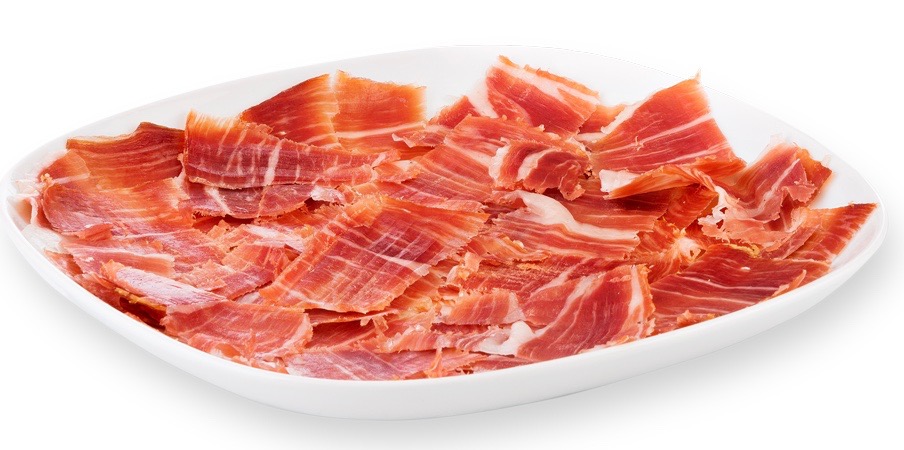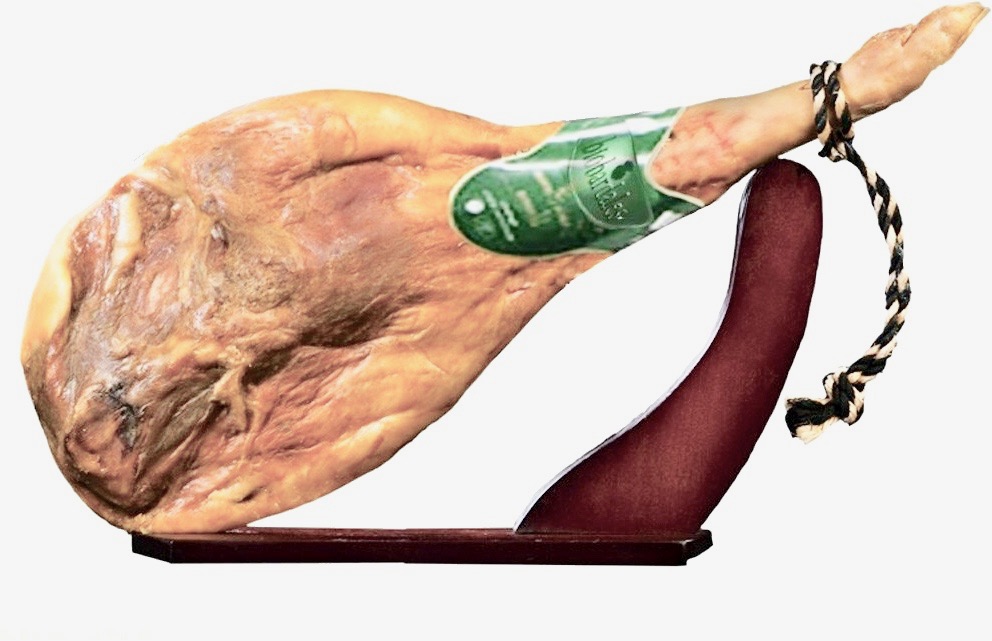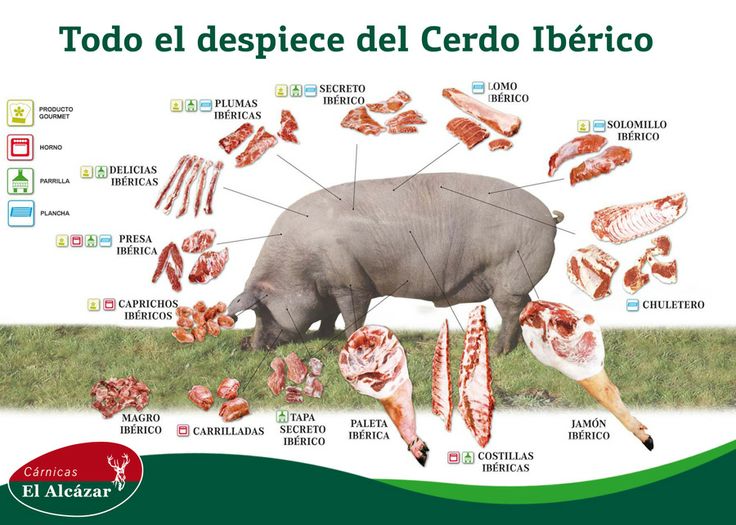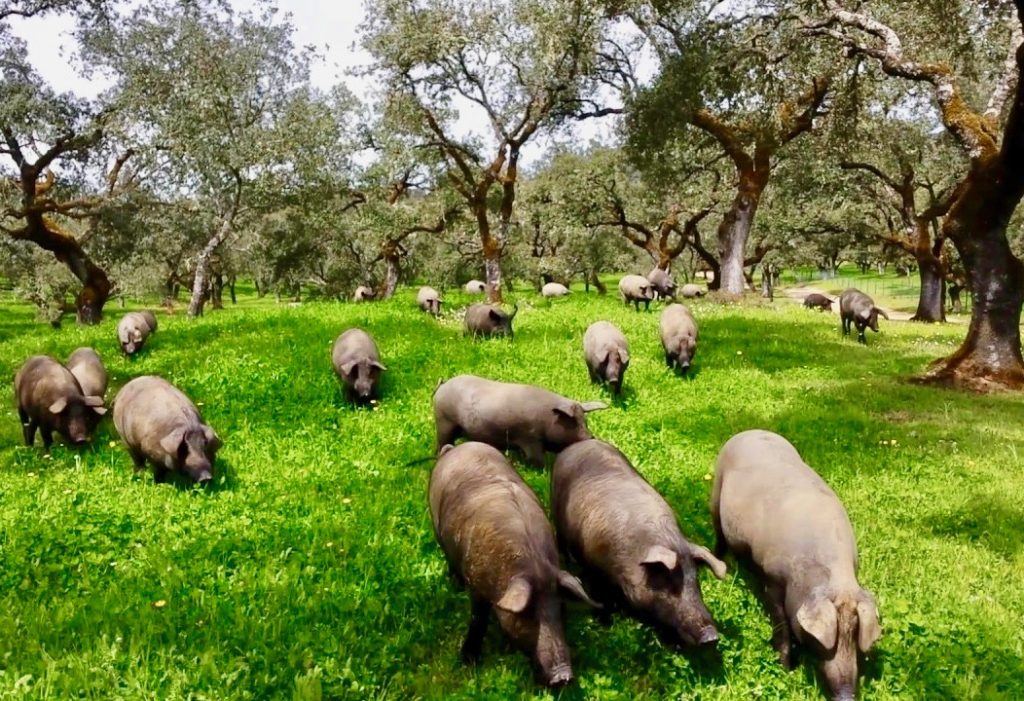HOLIDAY IN THE SUN

THERE IS NOTHING MORE SPANISH THAN
Jamon and Tapas
Since I have been in spain I have developed a taste for its cured hams without understanding the different qualities and prices. As the average Spaniard eats nearly 5 kilos of ham per year, and 40 million hams are cured every year, I thought that a little research was called for.
What is exactly Jamón Ibérico? What is different about Jamón de Bellota? And what is Jamón de Pata Negra? What are the different regions which as with wines are protected names, the so called “denominaciones”.
Let’s first take a look at the pig it all begins with – the so called Cerdo Ibérico (Iberian pig) is also called Pata Negra, because of its distinguishing grey colour, as opposed to “white pigs”. A white pig can be one of several different breeds, such as Duroc, Landrace, Large White and Jersey, the Iberian pig is a breed on it own, although one of its four grandfathers may be a Duroc or Jersey. Currently, 90% of the Spanish ham production comes from white pigs and only 10% from Iberian pig. Another difference is that the Iberian pigs weighs less and their meat has a refined taste, although much depends on what they eat.





The most influential factor on the final quality of the ham comes from what the pig has been eating. The best hams come from Iberian pigs that have been eating acorns (Bellota) all their lives. From October until January / February these pigs are left to roam the ‘Dehesa’, the countryside where they live on acorns. This period is called “montanera” after which the pigs are ready for slaughter.
Following their slaughter, the hams are immersed in nitrified salts to help dry and preserve them. The duration of this immersion depends on the ham’s weight: 1-2 days for each kilo, which usually works out to be 9-14 days. Then the salt is washed off and the hams are hung to dry for 30-45 days, at a temperature between 8º-10ºC and a relative humidity of 80%. This period is called “asentamiento”, a slow process during which the ham loses water and the salt gets absorbed and spread uniformly through all parts of the ham.
During the following 6 to 15 months, the curing process really starts and the ham changes to a deep red colour and gains the typical aromas of the cured meat. During the curing process, the temperature needs to be between one and five degrees with very low humidity. In earlier days, hams were taken to the mountains in order to meet the right temperature and humidity. The village of Trevelez in the Alpujarras are the living example of this tradition where you can visit the “secaderos” – dry houses. The last 3-4 weeks of this process is called “maduracion”: hams are exposed to temperatures of around 30º with a relative humidity of 60%. This way, the fats get well spread into the muscle fibres of the ham.
Most of the hams lose 40% of their original weight during these processes and are ready for sale. Only the best hams stay between 7-13 months more in “bodegas” for an additional curation, called “añejado”, during which the ham gains even more taste. Competing countries like France or Italy don’t apply this “añejado” process and this is why these hams are recognised by experts to be world’s best.
These processes will differ depending on the weight of the ham and also of the interpretations, experience and secrets of each ham-maker.
Now let’s take a look at the different ham you may encounter in Spain:
Jamón Serrano / Jamón Curado / Jamón Reserva / Jamón Extra
This is just the “ordinary cured ham” from white pigs, fed with a mixed diet of authorized commercial compound feed. The words Serrano, Curado, Reserva, Extra are just marketing terms and don’t tell us anything about the time of curing. Quality can differ strongly between different brands and is not easy to recognize. Price is usually a good indication.Jamón Ibérico / Jamón de Pata Negra
Only ham from the Iberian pig is allowed to be called Jamón Ibérico. If no mention is made of bellota, then take for granted that the pig was fed with authorized commercial compound feed and only if you’re lucky will acorns have been part of their diet. However, its taste is more refined than an ordinary Jamón Serrano.Jamón Iberico de Recebo
Ham from the Iberian pig which has been fed with acorns and authorized compound feed during the last months of feeding. This ham is a good compromise for those who don’t want to spent too much money on a ham but still want to experience its excellent taste. Jamón Iberico de Bellota / Jamón Iberico de Montanera Iberian ham from pigs that have been fed exclusively with acorns and herbs. This is the most refined ham available! Difference in quality depend now on the time of curation and the “know-how” of its producer.Paletilla
While ham is the hind leg of the pig, paletilla is the front leg. In other words… it’s not correct to say ham to a paletilla. Nevertheless, a paletilla can have an excellent taste and the same processes of ham-making apply. The difference? A paletilla is smaller and has more fat, therefore it’s cheaper. If you can’t afford a Jamón Iberico de Bellota, ask for a Paletilla Iberica de Bellota!Denominación de Origen
Only five regions are awarded the “Denominación de Origen”:- Jamón de la Dehesa de Extremadura
- Jamón de Huelva (including the famous Jabugo ham)
- Jamón de Teruel
- Jamón de Guijuelo
- Jamón de Trevélez
TAPAS
“La tapa” is eaten to sustain the body between meals.
Some assert that “the tapa” was born when, due to an illness, the Spanish king Alfonso the 10th (Alfonso the Wise), had to take small bites of food with some wine between meals. Once recovered from the disease, the wise king ordered that in all the inns of Castile’s land, wine was not to be served unless with something to eat. This royal providence was considered wise in order to avoid drunkenness in those who drunk the wine, and feed those who, hadn’t enough money to buy themselves a normal meal.
Alternatively consider the theory that “the tapa” first appeared, because of the need of farmers and otherworkers to take a small amount of food during their working time, so allowing them to continue on the job until the main meal time.
This main meal, with lots of fat, left the body so busy digesting that a “siesta” had to be taken for a couple of hours before going back to the fields or in the workshop. The longer the morning working hours took the less one had to do after the meal.
This snack needed wine, because alcohol enhanced the enthusiasm and the strength, and in winter it warmed the body up so as to withstand the very cold days in the fields and in the workshops. In summer, the drink to be taken in the South was “gazpacho” (cold tomato soup), instead of wine.
Once the “botellierias” (“bottle-shops”) and “tabernas” (taverns) were open throughout Spain, the King decreed that the glass or jar of wine was served covered with a slice either of smoked ham or cheese, with two aims: first to avoid that insects or other impurities could fall into the jar and also for the customers to soak up the alcohol they drunk with something solid. That was the origin of “la tapa” (a lid), a word rooted in Spanish tradition, a solid food that covered the wineglass. So the tapa’s tradition spread all through Spain, right to the present day, when it has been adopted and modified in other countries.
Spain still eats three main meals: breakfast, mid-day and evening.
The long time between breakfast, and the midday meal then the late evening meal, encourages the taking of a “tentempié” (snack), an appetiser or the “tapita”, when it is time for a social chat or discuss how the job is going.
The traditional drink to be taken with the tapa is wine, either “peleón” (young and cheap) or “reserva” (aged in oak-barrels) wine of each region: young “txakolí” in the Basque Country, Penedés wine or Cava in Cataluña, “ribeiro” in the Northwest, young Valdepeñas or Rioja wine in Castile and in the centre, or fine sherry in the south. In Asturias and in northern parts, where apples grow widely, cider replaces wine.
The tapas’ receipes vary according to the traditions of each region. But usually, olives in its many varieties are often used, as well as different dry nuts and all kinds of cold cuts.
The green, Manzanilla, machacadas (crushed), gordales (big), rellenas (stuffed), aliñadas (flavoured) or deshuesadas (stoned), could by themselves fill a book of tapas. Together with the olives, slices of garlic or smoked-ham sausages, slices of cheese or jamón curado became world-wide known. Tapas recipes use all sorts of food: meat, fish, vegetables, eggs and any other product could enter the tapas’ world.
There are fried ones – “boquerones” (whitebait), calamaries, sausages, doughnuts, croquets, potatoes and “torreznos” — Casseroles and stews, like the madrilenian “callos” or the Almagro’s aubergines, or the flavoured string beans. And finally, recipes like potato tortilla, codfish doughnuts,. Croquets and escabeches remain obligatory at this time of the day and, accompanied by a salad, could perfectly replace a complete lunch.
Today, additional to those traditional snacks, new ones have appeared, some of them used to be only to be seen on a properly dressed table, like the “paella” or the stewed potatoes with meat — other foreign recipes have arrived as tapas like smoked salmon, pate or caviar, vegetables spring rolls, smoked fish from the northern countries, German sausages, Swiss melted cheese and cakes or pate.
The art of eating tapes can replace the need for lunch or dinner where there is sufficent quantity and choice.
But, without any doubt, the most singular aspect of the “tapa” is in its position promoting companionship, and informal ritual. The elegance of the tapeo, the aesthetic of the rite, belongs in a sort of indifference to the table and the chair, and even to the food that, although delicate and tasty, is eaten standing, and in small portions, even the verb “to eat” is rejected in favour of “to scratch” as used in the bird world.
Speech and gesture is all part of “tapeo”. The art of eating on foot has almost sacramental appearances. The “tapas” are a very characteristic part of the Spanish cooking tradition that impossible to be exported to other cultures, but it has become popular everywhere in the world
Why not! The tapeo would be, without a doubt, the best fast food formula if it did not require time and a break long enough to practice the Spanish elegance the art of eating while standing.
USE THESE QUICKLINKS TO NAVIGATE THIS SITE